
Stipa is a genus of around 300 large perennial hermaphroditic grasses collectively known as feather grass, needle grass, and spear grass. They are placed in the subfamily Pooideae and the tribe Stipeae, which also contains many species formerly assigned to Stipa, which have since been reclassified into new genera.
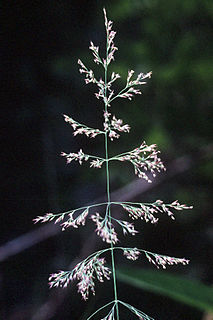
Calamagrostis is a genus of flowering plants in the grass family Poaceae, with about 260 species that occur mainly in temperate regions of the globe. Towards equatorial latitudes, species of Calamagrostis generally occur at higher elevations. These tufted perennials usually have hairless narrow leaves. The ligules are usually blunt. The inflorescence forms a panicle. Some may be reed-like.
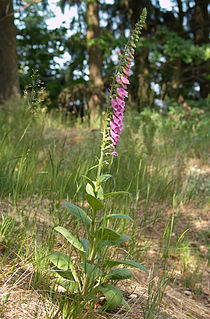
Digitalis purpurea, the foxglove or common foxglove, is a poisonous species of flowering plant in the plantain family Plantaginaceae, native to and widespread throughout most of temperate Europe. It has also naturalised in parts of North America and some other temperate regions. The plant is a popular garden subject, with many cultivars available. It is the original source of the heart medicine digoxin. This biennial plant grows as a rosette of leaves in the first year after sowing, before flowering and then dying in the second year. It generally produces enough seeds, however, so that new plants will continue to grow in a garden setting.
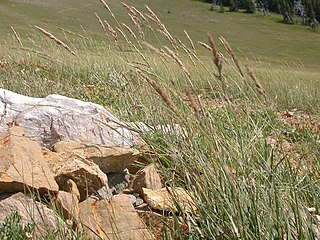
Calamagrostis purpurascens, is a perennial grass commonly known as purple reedgrass, purple pinegrass, or alpine reedgrass. It grows 30 to 80 centimetres (31 in) tall.

Calamagrostis epigejos, common names wood small-reed or bushgrass, is a species of grass in the family Poaceae which is native to Eurasia and Africa. It is found from average moisture locales to salt marsh and wet habitats.

Sarracenia purpurea, the purple pitcher plant, northern pitcher plant, turtle socks, or side-saddle flower, is a carnivorous plant in the family Sarraceniaceae.
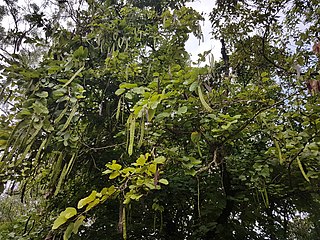
Bauhinia purpurea is a species of flowering plant in the family Fabaceae, native to the Indian subcontinent and Myanmar, and widely introduced elsewhere in tropical and subtropical areas of the world. Common names include orchid tree, purple bauhinia, camel's foot, butterfly tree, and Hawaiian orchid tree.

Deschampsia is a genus of plants in the grass family, commonly known as hair grass or tussock grass. The genus is widespread across many countries.

Hakea purpurea is a flowering plant in the family Proteaceae shrub and grows in Queensland and New South Wales. It is a small shrub with needle-shaped leaves and clusters of red flowers in late winter to early spring.
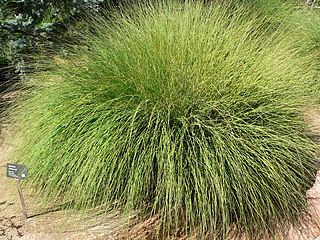
Muhlenbergia is a genus of plants in the grass family.

Achnatherum is a genus of plants which includes several species of needlegrass. Several needlegrass species have been switched between Achnatherum and genus Stipa; taxonomy between the two closely related genera is still uncertain.

Calamagrostis arundinacea is a species of bunch grass in the family Poaceae, native to Eurasia, China and India. Under its synonym Calamagrostis brachytricha it has gained the Royal Horticultural Society's Award of Garden Merit.

Tussock grasses or bunch grasses are a group of grass species in the family Poaceae. They usually grow as singular plants in clumps, tufts, hummocks, or bunches, rather than forming a sod or lawn, in meadows, grasslands, and prairies. As perennial plants, most species live more than one season. Tussock grasses are often found as forage in pastures and ornamental grasses in gardens.
Aniselytron is a genus of Asian plants in the grass family.

Tristachya is a genus of African and Latin American plants in tribe Tristachyideae within the grass family.
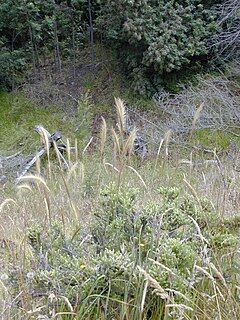
Dichelachne is a genus of Australian, Indonesian, and Pacific Island plants in the grass family. They are known commonly as plumegrasses.
Lachnagrostis is a genus of African, Australian, Pacific Island, and South American plants in the grass family. They are often treated as members of genus Agrostis.

Epichloë baconii is a haploid sexual species in the fungal genus Epichloë.

Calamagrostis × acutiflora, called feather reed-grass, is a naturally occurring hybrid species of grass in the genus Calamagrostis, occasionally found in Europe and Asia. Its cultivar 'Karl Foerster' has gained the Royal Horticultural Society's Award of Garden Merit.

















